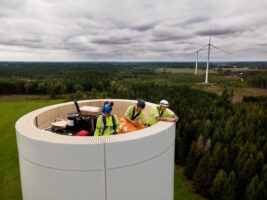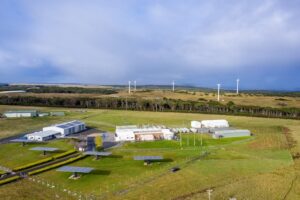A Norwegian research team has demonstrated a relatively simple and potentially very effective way to drastically reduce the number of bird deaths at wind farms, by painting one of the three blades of a wind turbine black.
In a study conducted over 10 years at a 68MW wind farm on the Norwegian archipelago of Smøla, the research team found an average of nearly 72% reduction in annual bird fatality rate at painted turbines, compared to non-painted control turbines.
The team from the Norwegian Institute for Nature Research said the contrast painting method significantly reduced the fatality rate for a range of birds at the Smøla wind farm, but appeared to be particularly effective for raptors.
“Before the experiment, six white‐tailed eagles were found dead at to‐be‐painted turbines but after painting none,” the research team said in a report published in the journal Ecology and Evolution.
“The reduction of these carcasses was assessed to be very unlikely due to random chance. Norway is considered a stronghold for this species, and the Smøla archipelago supports very high densities.”
The team believes the contrast painting method works by reducing the “motion smear” of spinning all-white turbine blades, which could render them almost invisible to birds. That’s because birds have a narrow frontal field of view and instead rely on their high-resolution lateral fields of view for detecting predators and prey.
“Our prediction was that the painting would increase the visibility of the blades, as this reduces the visual smearing effect once the blades are rotating, and that this would lower the collision risk,” the team said.
And in this study, at least, the theory appears to carry some weight.
“Overall, there was an average 71.9% reduction in the annual fatality rate after painting at the painted turbines relative to the control turbines,” the report says.
“The visual acuity of birds, relating both to the spatial and temporal resolution may well enable birds to anticipate the turbines with reduced motion smear more rapidly.
“The ultrarapid vision of birds possibly enables them to quickly become aware of the turbines with a painted rotor blade.”
The team recommends either replicating the study, preferably with more treated turbines, or to implement the measure at new wind farm sites and monitor collision fatalities to verify whether similar results are obtained at other locations.
“It is of the utmost importance to gain more insights into the expected efficacy of promising mitigation measures through targeted experiments and learning by doing, to successfully mitigate impacts on birdlife and to support a sustainable development of wind energy worldwide,” the report says.
The impact of wind farms on bird populations has long been a contentious issue and efforts to mitigate it have given rise to a range of preventative technologies, including radar detection systems that monitor bird flight and adjust the operation of wind turbines to help avoid collisions.
In Australia, a Dutch version of this technology is being tested at Tasmania’s Musselroe Wind Farm, in a bid to reduce the impact on wedge-tailed eagles.
Also in Tasmania, Goldwind Australia has been testing IdentiFlight technology, by developers of the same same, at its Cattle Hill project.
Last year, the UPC/AC Renewables’ Robbins Island wind farm, which proposes to construct 340MW worth of wind turbines in Tasmania’s north-west, was met with unexpected opposition from former Australian Greens leader Bob Brown, who specifically cited the project’s potential impact on wedge-tailed eagle populations as a reason for his objections.










